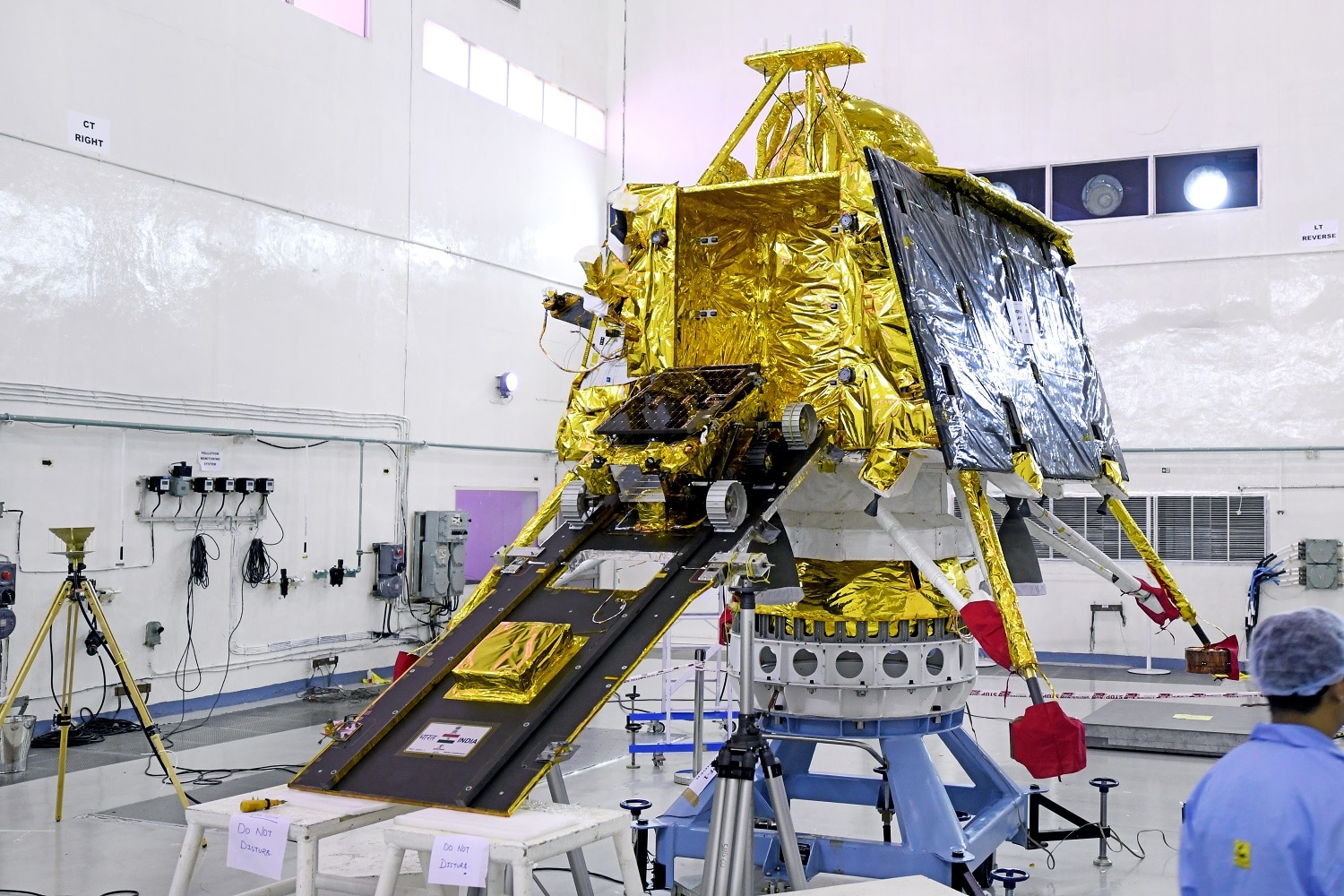India
Chandrayaan-2 is India’s ambitious project to explore the Moon
Only the US, China, and Russia have achieved this so far

Fifty years back the United States became the first country to send man to the Moon. Since then, many countries like the former-Soviet Union, China, and the EU have tried to accomplish similar feats. Thanks to advancing technology, we no longer need to send humans to the Moon for exploration. Rovers and satellites have sufficient capabilities to explore the surface and all operations can be handled remotely.
The Indian Space Research Organisation (ISRO) has been at the cutting edge of technology and managed to make huge strides in space exploration. The agency is India’s backbone for sending satellites and has a spectacular track record of successful launches. Their first mission to the Moon was Chandrayaan-1 and it was launched in 2008. The spacecraft was able to complete 95 percent of its objectives before a connection was lost and it crashed on the Moon’s surface.
Now, India is back with a new project called the Chandrayaan-2. Chandra means Moon in Sanskrit and Yaan means a vehicle, the project marks the entry of the developing country in an elite club of nations with similar space exploration capabilities. In fact, the mission has cost just INR 1,000 crores, equivalent to US$ 145 million. For comparison, a single Transformer movie costs upwards of US$ 200 million.
This cost-effective method of research and development gives India a unique edge. The Chandrayaan-2 intends to do a soft-landing on the surface of the Moon. So far, only the US, China, and Russia have been able to master soft landings and India aims to join the list.
The Chandrayaan-2 spacecraft consists of an orbiter named Vikram and a moon rover called Pragyaan. The landing module sits on top of the rocket and is covered in a composite golden film to protect the components from extreme temperatures. The surface rover is safely tucked inside the lander and shall come down a ramp once the soft-landing is complete.
Propelling the spacecraft is a GSLV Mk 3 rocket (Geosynchronous Satellite Launch Vehicle) that’s 44 meters tall and weighs 640 tons. After separation, the Chandrayaan-2 spacecraft will travel 3.84 lakh kilometers and land near the South Pole of the Moon, a region which hasn’t been fully explored by humans yet.
The mission was supposed to launch in the early hours of July 15 but a last moment technical snag in the rocket delayed the launch. Now, ISRO has announced Chandrayaan-2 will be launched on July 22 at 2.43 p.m. from Satish Dhawan Space Centre in Sriharikota. The country also plans to send a manned mission to the Moon in the coming years and has tied up with multiple international companies for transfer of technology.


There’s no doubt that India is a major market for technology. While the country has its own brand preferences outside of the world’s usual, everyone still wants to get a piece of the market. To the dismay of global companies, the country is realizing the potential of its own market. Effective immediately, India has started restricting imports for new laptops, tablets, and PCs.
Recently, India made some headlines in the smartphone industry. A few companies, including Apple, have poured funds into building factories in India. Locally produced devices will allow these companies to attract the Indian market better. With the new regulations out today, it looks like these brands are going to enjoy a head start over others who aren’t in the country yet.
The Indian government introduced a new restriction (via Reuters) against the importation of “laptops, tablets, all-in-one personal computers, and ultra-small form factor computers and servers” made from other countries. Customers, however, will get an exemption. Airline passengers can still bring in these devices in their luggage. Additionally, a single imported device is allowable when bought through e-commerce platforms. Companies can import their products only by applying for a special license.
In a nutshell, bulk orders without a license are out. The government is instead encouraging users to buy locally produced products as part of its “Make in India” program. At the very least, it’s not a total ban on foreign brands. For example, Dell, HP, and Lenovo are exempt from the regulations since they already have production facilities built in the country.
SEE ALSO: Samsung overtakes Xiaomi as top phone brand in India

Attacking a huge smartphone market is difficult. With preferences constantly evolving, it can get tricky to figure out the best lineup to capture most of a market. Samsung, however, has just done it. In the last quarter of 2022, Samsung has taken the crown from Xiaomi as the bestselling smartphone brand in India.
India is an important market for most smartphone brands. It’s one of the largest markets in the world. However, despite its size, the biggest players are often those who offer more affordable devices for consumers. Budget is the name of the game if a brand wants to make it big in the country.
Things are changing, though. According to new market data (via Reuters), Samsung has nabbed the throne from the former leader, Xiaomi. In the last quarter of 2022, the Korean brand grabbed 20 percent of the market, while the latter only got 18 percent.
In a trend dubbed as premiumization, Indian consumers are reportedly enjoying more disposable income, resulting in more willingness to buy pricier products. Additionally, the report hints that consumers have started equating lower prices with inferior quality.
With the market trending towards more premium products, Samsung took the lead with a lineup that consists more of midrange to premium devices. It will also be interesting to see if Apple, an even more premium brand, can also make a dent in the Indian market.
SEE ALSO: Buyer’s Guide: Samsung Galaxy S23 Ultra

For one of the largest smartphone markets in the world, India is one of the rarer countries where Apple does not outright dominate. Undoubtedly, the company is trying to change that. Ongoing job listings in India are suggesting that Apple is ready to open its first brick-and-mortar store in the country.
First reported by Financial Times, Apple has posted job openings in India for several retail roles including for the iconic Genius Bar. Another clue even indicates that some spots have already been filled ahead of time. A few employees in the country have reportedly posted about their new jobs on LinkedIn.
Unfortunately, none of the job listings show how many stores are planned and where they will be. Narrowing things down by a bit, a few of the confirmed employees are from Mumbai and New Delhi. The report also does not indicate when the stores will open. However, since a few have already been hired, a grand opening might be coming soon.
Apple has a lot to gain by strengthening its foothold in India. The country is an important stronghold for smartphone companies. However, the company might find things harder as time goes by. The country recently dictated that brands must switch to USB-C if they want to sell their devices in India. All over the world, Apple remains the last stalwart against adopting the more universal standard.
-

 Accessories2 weeks ago
Accessories2 weeks agoApple Vision Pro Review: Two Months Later
-

 Features4 days ago
Features4 days agoFortify your home office or business setup with these devices
-

 Gaming1 week ago
Gaming1 week agoThe Rogue Prince of Persia looks like an ultra-colorful roguelite
-

 Philippines2 weeks ago
Philippines2 weeks agovivo Y100 to release in Philippines on April 27
-

 Deals2 weeks ago
Deals2 weeks agoSamsung Awesome April: Deals on Galaxy A series
-

 Gaming1 week ago
Gaming1 week agoStar Wars Outlaws release date revealed
-

 Accessories1 week ago
Accessories1 week agoLogitech unveils G Pro X 60 gaming keyboard: Price, details
-

 Events1 week ago
Events1 week agoStellar Blade: PlayStation taps cosplayers to play Eve for game’s launch























